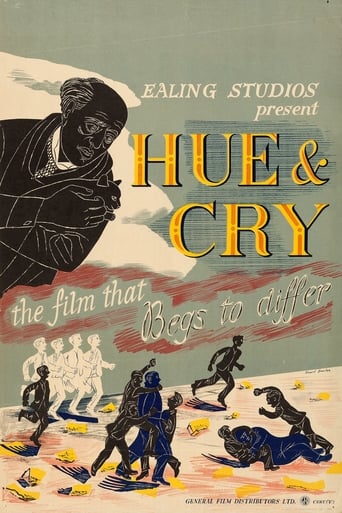MartinHafer
This apparently was the first comedy by Ealing Studios, and while it is far from their funniest, it was amazingly good and set the stage for even better films to follow. It's a fanciful story that is reminiscent of some of the films of the 1980s and 1990s where kids are smart and need to teach the grownups a thing or two--something that was very novel in 1947.The film begins in London just after the war. The film is interesting because of all the still-evident bomb damage from the blitz. It's all about a group of precocious kids--one in particular. Through some strange coincidences and clever thinking, they figure out that a gang is using a comic page in the newspaper to broadcast instructions to the individual members. However, when the gang get wind of this, they turn the table on the kids and now the police won't believe their wild story about secret codes and robberies. So, it's up to the kids to take the law in their own hands and save the day in one of the more rousing finales I've seen in a long time.Excellent and original, this one is well worth a look due to clever writing as well as an ending that is very hard to forget.
writers_reign
I shudder to think what the 'academics' will talk this one up. Consider: a determined group of 'little' people triumph over a gang of bullies aided no little by 'cracking' a code. I can hear them now in Film 'schools' the length and breadth of the land 'explaining' how to 'read' this as a metaphor for an England who had just won - with a little help from their friends - a major war against Germany aided by their cracking of the 'Enigma' code. I doubt whether screenwriter Tibby Clarke had anything more meaningful than a paycheque in mind when he dreamed up this yarn in which a group of unsophisticated teenagers without an 'O' level between them, uncover a plot involving a weekly comic book for boys which villains use to communicate details of proposed robberies. Alistair Sim is top-billed but as the writer of the serial he has only two scenes whilst Harry Fowler as the leader of the boys appears in virtually every one. It's all a tad gung-ho but given that it was shot in 1946 that's to be expected. Though it's an Ealing film it's meant to be serious so do try not to laugh.
tedg
Sometimes a film is worth it just because of an accident. In this case the accident is that the Germans (not the Nazis, the Germans) had decimated large parts of London, and we had that as a set for this little drama.Its a great little story too, perfect for this very successful notion of noir light.Its the old fold: writer writes and the fictional becomes real. The only concession to reality — which incidentally allows it to be inserted into the noir world — is that what the writer writes is tampered with on the way to the book.One scene toward the beginning is particularly nice, where a boy reading a comic sees the same thing in reality. I recommend "How to Murder Your Wife" as a much better entry in this minigenre. But this is good too. At least the first half. The second half (after the great, really great sewer scene) is a sort of noir Bowery Boys gets their man.Ted's Evaluation -- 3 of 3: Worth watching.
greadman
When I was a 'nippah', I used to go to the cinema on a Saturday Morning, this was one of the films that they showed. It made an impact on me that I always watch it again and again.A film made in the bombed out post-war east London. It was a proto brat-pack movie (watch out for a very adolescent Anthony Newley). This film is a treasure and a classic that transcends time and generations. The plot is around a bank robbery, but around this are the bombed out scenes of the East End of London, in which the kids made their playground. These scenes are contrasted with the bright, sparkling and summery photography. There are many memorable scenes. Such as the boy re-enacting an aerial dogfight on a bombsite. He makes noises of aircraft, machines-guns, flak and bombs. These are complemented by his gestures. This scene has a genuine intensity to it, the war had obviously made an impact on him, and this intensity is shared. The other scene is that when the group of youth have to negotiate the sewer, we are shown into a subterraenean world. This had to be filmed on location, how could you build a sewer in the studio on a limited budget?. There is also the other scene where the gang manage to trap one of the female villains, they extract the necessary information from her by one of the boys threatening to unleash one of his pet white mice on her.


